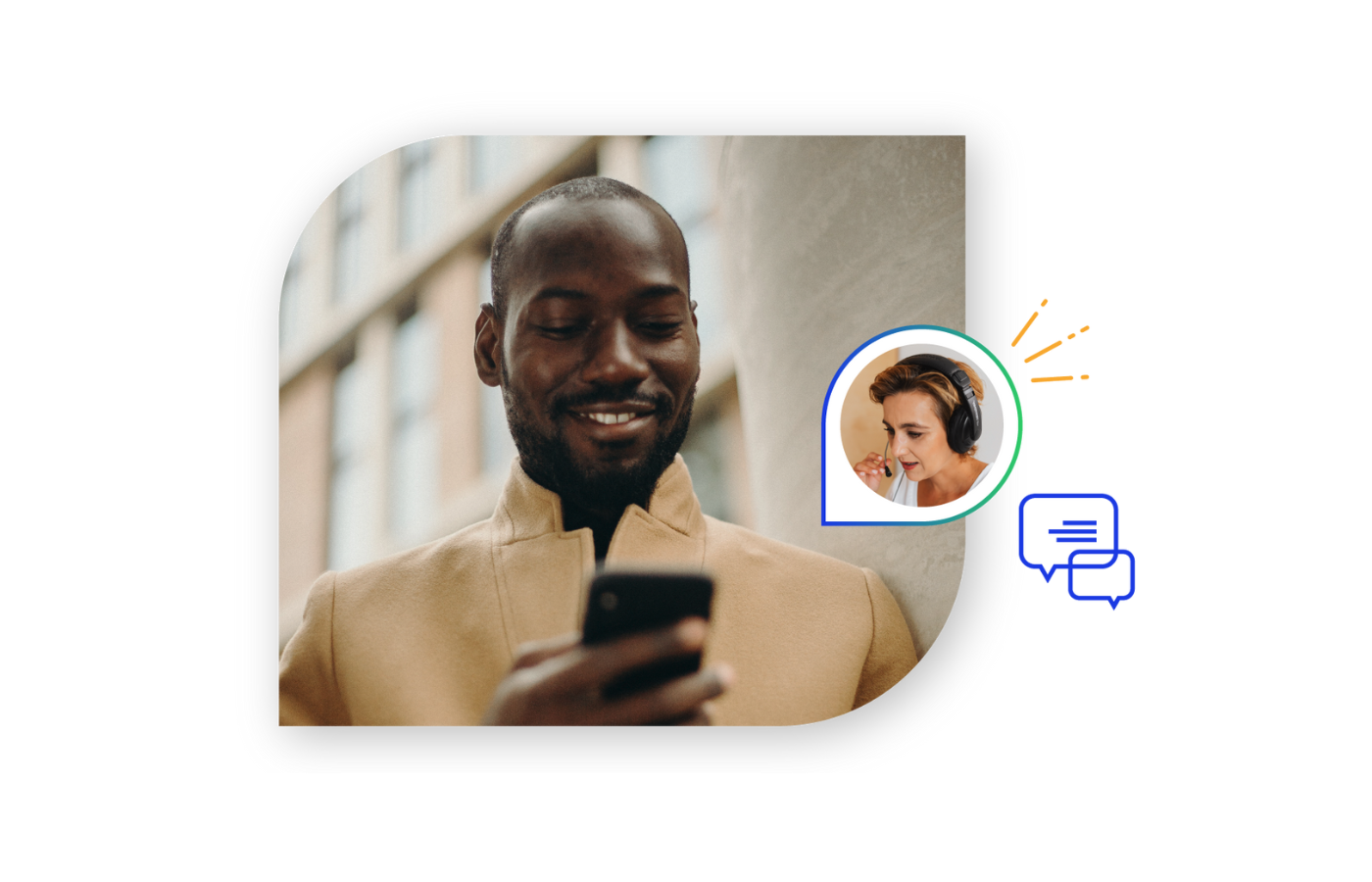Your agents are looking good. Your lighting is perfect. Your sound and background check out. Your image is stellar.
You have successfully guided your team through all of the necessary visual considerations for video chat, and are well on your way to becoming an exemplary video chat customer service operation. There is still one thing left to consider though – and that’s the service itself.
The answer lies in the difference between live chat and video chat customer service. Your live chat team has mastered delivering customer service with keystrokes. But successfully executing customer service over video chat comes with its own unique set of considerations and challenges. If your team fails to deliver great customer service over video chat, it won’t matter if your agents look and are lit up like a bunch of Hollywood actors: the end result will ultimately be disappointing.
This blog post will cover the top last-minute customer service considerations to go over with your video chat agents before sending them out into the virtual field.
-
Watch Your Posture
Making sure that your agents have good posture may not be paramount to live chat. However, because video chat removes the visual barrier separating your live chat agents and your customers, your customers will be able to notice your agents’ posture, and take it into consideration when judging them and/or the service.
Slouching sends the message that your agents are tired, bored, and disengaged. It can also be read as an expression of how your agents perceive themselves. A study of 74 people in New Zealand found that participants who sat up straight felt “more enthusiastic, excited, and strong, while the slumped participants reported feeling more fearful, hostile, nervous, quiet, still, passive, dull, sleepy, and sluggish.” The study also found that good posture was associated with higher self-esteem, less social fear, and fewer negative emotions.
Agents who slouch while on a video call look smaller, and as a result less confident and assertive than their up-right counterparts. Think of it in terms of in-store representatives: who would you rather have assist you, a slouching, hunched over employee, or an up-right, chin up representative?
Slouching on video chat can result in a misalignment of the webcam, and can force your customers to look slightly down at your agents (remember, your agents’ webcams should be at eye-level, and slouching can ruin this calibration). It also affects your agents’ tone of voice – someone who is slouching won’t sound the same as a person who is sitting up straight.
And, slouching is bad for your agents’ health. According to Dr. Jason Queiros, a Chiropractor at Stamford Sports and Spine in Connecticut: “People who sit at a desk for a long period of time tend to roll their shoulders in and hang their head forward. Every inch you hold your head forward, you add 10 pounds of pressure on your spine. Let’s say you’re leaning into your monitor by just two inches, that’s 20 extra pounds that your back and spinal column have to endure.” This can lead to health issues such as:
- Tension headaches – bad posture overworks your neck and back muscles. Once you finally come home and relax, the muscles can tense up, causing painful headaches.
- Jaw pains – a misaligned spine puts extra stress on your lower jaw joints, and shifts your lower jaw forward. This can cause jaw pains and muscle pains at the back of your head.
- Spine alignment issues – if your spine isn’t aligning properly, it can affect your rib cage, which can damage your heart and lungs and also lead to gastrointestinal issues.
Training tips:
- Encourage your agents to keep their backs erect, their shoulders back, and their chins up. This will help them look and feel more sure of themselves and improve their posture in general. If they feel like they are too far from their computers, instead of hunching in closer, have them scoot their chairs in and/or move their monitors towards the front of the desk. Encourage them to squeeze their shoulder blades together while at work for an instant posture correction. You should also ask that your agents uncross their arms, to keep their posture inviting (arms crossed over the chest is a defensive posture).
- Consider having a brief meeting in order to introduce these and other easy techniques to stop slouching. You may also want to offer a prize or incentive to the agent who manages to have the best posture while helping customers, or who shows the most dramatic improvement within a month’s time.
- Consider inviting a yoga instructor and/or a chiropractor into the office, to practice stretching techniques that will help your agents better their posture, and to educate your agents about the benefits of good posture.
-
Speak Clearly
Video chat has one thing in common with traditional phone support: verbal communication is expected. Live chat agents who are accustomed to typing their way towards a resolution will need to know how to speak clearly to customers to ensure their satisfaction and understanding of the solution. Speaking clearly includes using good pronunciation, enunciation, speed and volume of speech, and clarity of thoughts.
Good pronunciation is especially important for live chat agents who work abroad and have a foreign accent that their customers may not be used to hearing. Customers of companies who outsource their call centers to agencies overseas often find themselves struggling to receive help from agents whose accents they can’t understand. This can be an extremely frustrating experience for both the customers and the agents; it can discourage customers from trying to resolve their issues or from buying from the company in the future, and result in unfulfilled, insecure employees.
Training tips:
- To help agents who don’t share a native language with your customers practice good pronunciation, try introducing them to podcasts and video guides what will help them pronounce key problematic phrases better. You can record these practice sessions, and play them back to your agents, so that they can see what they are doing differently that still needs to be corrected.
From one region to another, different pronunciations are always going to exist. This is part of why enunciation is so important. Proper enunciation has to do with how clearly your agents are voicing each word to your customers. When your agents enunciate well, you will be able to limit misunderstandings between customers and agents, regardless of external factors such as call quality and background noise on your customer’s end (remember, you already know how to limit and/or get rid of your own background noise!). Proper enunciation makes your agents more intelligible, which can help compensate for any regional accent differences. It can even avoid upsetting customers who may mistake a poorly enunciated but innocent phrase for something very different.
Training tips:
- Encourage your agents to practice speaking slowly while looking in the mirror. By watching their slow, intentional mouth movements, your agents will notice any sounds that they are accustomed to mumbling or slurring.
- You can also consider printing out a sheet of fun consonant-vowel combinations (“Bah Beh Bee Bih Bo Boo Buh”) and tongue-twisters (“The sixth sick sheikh’s sixth sheep’s sick”) that your agents can practice between video chats.
- Agents can take this a step further by practicing these exercises (or just speaking in general) with a pencil in their mouths – that way they will have to work much harder around a physical speech impediment, and enunciating will therefore become easier when they are speaking pencil-free.
Pace and volume is just as important to clear speech as enunciation: live chat agents who are not used to speaking with customers may unintentionally speak too quickly, or too softly, for your customers to understand them. To avoid this, agents should shoot for a moderate pace and volume. They should speak loudly enough that their customers don’t have to strain to hear them, but not so loudly that they disrupt the conversations that are happening around them.
The same goes for speed – you don’t want your agents to speak so slowly that their conversations takes forever, or that your customers grow irritated (on the other hand, speaking more slowly and inserting pauses at the right time can help your customers feel more engaged, and sends the message that you want to be talking to them). Agents also shouldn’t speak so quickly that their customers only catch part of what they are saying, and feel like they are being rushed to finish the conversation.
Fast speech can also compromise the clarity and thoughtfulness of ideas. Agents who speak too quickly run the risk of saying something before their thoughts catch up to them. This can make your agents hard to understand because of the lack of clarity in what they are sharing, not just how they are sharing it.
Training tips:
- To train your agents to speak more slowly and at the right volume, show them an example recording of what the proper speed and volume looks like. Even better, draw attention to an agent who speaks at an exemplary volume and pace. This way, should your agents get caught up speaking too quickly, they can refer back to that agent in order to recalibrate.
- Encourage your agents to use customer feedback to readjust as necessary – some customers are going to need things to be repeated louder and more slowly. If a customer asks for that, make sure that your agents are obliging, and slowing down and speaking up accordingly.
-
Watch Your Tone
Tone of voice is another consideration that many live chat agents aren’t used to accounting for when handling customers. Although tone can be conveyed over live chat with exclamations, periods, and smiley faces, these implementations are much more intentional that the tones that escape in direct conversation.
Video chat agents should greet customers with a positive tone, and carry on the conversation in a tone that is positive to neutral. The best way to create a positive, friendly tone is by having some varied pitches in your voice. Stressing important words with a higher pitch can have the effect of reassuring listeners, while using lower pitches can bring an element of calmness to your voice. Using these two pitches together creates a dynamic, approachable tone (use only high pitches and you’ll sound like you’ve breathed in a helium balloon – use only low pitches and you’ll sound uninterested in the conversation). Have your agents avoid being monotone to keep from boring your customer to death, or seeming like your agents are bored to death themselves.
If your agents are having a bad day, make sure that they don’t inadvertently take it out on your customers by using a rude tone with them. Live chat agents can reread messages before sending them to make sure that they don’t sound hostile. Over video chat, that possibility doesn’t exist. Encourage your agents to think about what they are going to say before they say it, just in case there is a chance that their tone or word choice could be heard in a negative light.
Training tips:
- Do a training activity where you have agents repeat the same phrase, but applying different emotions to it, then have them discuss how it felt to speak and hear those statements. For example, you might have them say, “Have a great day,” but in a bored, excited, sarcastic, etc. tone of voice. This can open the doors to some great discussion about how many of us aren’t aware of how our mood can affect tone of voice so drastically, and how negative tones of voice impact the listener.
-
Avoid Fidgeting
While helping customers over live chat, nothing stops your agents from fidgeting at their desks. Your live chat agents might be used to swiveling around in their chairs, checking their phones, biting their nails, drumming their fingers on the desk, tapping their feet restlessly, playing with their hair, or even playing with fidget spinners while chatting with customers.
However, over video chat, all of these things are big no-no’s. The fidgets that your live chat agents have always partaken in unconsciously may at best be a minor distraction to customers – at worst they can be incredibly irritating and unprofessional. Fidgets that take agents’ eyes away from their customers (such as checking cellphones) can even insult and upset customers. After all, they are reaching out to your company via video chat because of the personal, connected nature of the service – not to watch your agents pay attention to their nails or cellphones.
Training tips:
- Have your agents watch back videos of them video chatting. Most agents (and people in general) are very critical when seeing themselves recorded, and will immediately hone in on things they do which are unconscious but distracting.
- Not everybody fidgets for the same reason. Some agents might fidget due to anxiety, hyperactivity, ADHD, or just because they have something on their mind. You may want to have a one-on-one conversation with agents who you notice can’t seem to keep still, even after watching the playback of them chatting. From there, you can encourage them to think about why they are fidgeting, and gently recommend steps to break the habit, such as taking up a better diet, exercising more, and limiting caffeine and sugar intake. Practicing relaxation techniques, such as controlled breathing, meditation, yoga, and gratitude can also help reduce stress and restless energy.
-
Avoid Obvious Multitasking
Imagine that you are mid-video chat with a friend or family member. You open Facebook or your email account to check something and suddenly your mind is no longer in the conversation. You give a disengaged “uh-huh,” as your friend or family member continues to speak, their words going in one ear and out the other. By the time it is your turn to respond, you realize that you have barely been listening and you have no idea where the conversation is at. You have two options: (1) You either admit that you spaced out and ask them to repeat themselves, or (2) you smile, and give a generic reply – trying to work your way around the gaps like nothing happened.
While a friend or family member might be understanding in this scenario, most customers won’t be so forgiving of distracted service. Multitasking is another habit that is common (even encouraged) during live chat, but that won’t go over well while video chatting.
Have your agents avoid any obvious multitasking that is unrelated to the customer’s issue. Since your customers can see and hear your agents, any distraction or lapse in listening will be apparent, and potentially upsetting to your customer. Should your agents need to pause to look something up, or to type something out for your customer, have them explain what they are doing while or before they begin to disengage – not after. Ask that your agents also avoid looking down or to the side while on video call – you want your customers to be the center of attention while they are on the line. Any distraction and your customers might begin to wonder and what is going on (why is my agent looking down? Is he/she checking his phone? Why is my agent looking to the side? Is something going on that I should know about?) and form judgements based on their assumptions.
Training tips:
- Create a “Singletasking” workshop for your agents, to help them come out of the multitasking mindset. Help them begin to consider what tools they need to get their work done, and how to eliminate tools that are not necessary in this process (do they really need their web browser to be open while they chat with customers? Can they close some programs and/or sign out of email until the end of the day? Where can they put their phones so that they are not tempted to look at them at an inappropriate time?). These tools, after all, are there to make our lives easier, not harder, and should be used as such.
- Be sure to address when and how multitasking is okay or expected (such as beginning the wrap up process for a video chat), but urge agents to either be very open about their multitasking, or do so very discretely. The shift to a “singletasking” mindset at work might even help your agents’ outside of the office too – although it might not be easy at first, there is power and relief in learning to give something your 100% focus.
-
Make Eye Contact
It can be tempting for your video chat agents to not look at your customer. After all, looking at the camera, rather than at the little box that shows your agents what they look like, takes some getting used to.
However, eye contact is an indispensable part of conveying engagement, and even if your agents can’t literally look into your customers’ eyes, they should at least look like they are doing it. Eye contact shows your customers that your agents are confident, trustworthy, good listeners, and that they are focused and paying attention. Avoiding direct eye contact on the other hand can communicate insecurity, shyness, a short attention span, or make it look like your agents have something to hide.
While your agents are on a video call, have them look directly into the camera as often as possible. This will give the illusion that your agents are making direct eye contact with your customers. Any time that is not spent looking at the camera, your agents should be looking at your customers’ video feed. Agents should keep the window open and full-sized, to avoid missing any key visual cues or reactions from your customers.
Training tips:
- If your agents can’t yet avoid looking at the little window that shows their own video feed, drag this little window to the highest point possible on your computer, so that it rests the smallest distance possible beneath the webcam. This will help your video chat agents begin to train their eyes to look up and directly into the camera.
- Another idea is to encourage your agents to tape a small photo or something eye-catching to an unobtrusive place just beneath or above their webcam, to serve as a reminder of where to keep their eyes.
- You may also want to consider setting up a dual monitor for your agents, so that they can keep their customers in full screen, while using the other monitor to complete any troubleshooting operations.
-
Smile
Chances are, your live chat agent isn’t used to physically smiling as they type to customers. However, smiling is an important tool for video chat, and is basically expected in any form of face-to-face customer service (how well are you going to tip a waiter who doesn’t give you a single smile? How good are you going to feel about asking help from an in-store representative that doesn’t look in the least bit happy to help you?)
Smiling makes customers feel welcomed into the video chat session. It can help ease any frustrations or irritations that they have brought with them into the chat, and show them that someone is ready and eager to help them with their problem, question, or concern. Smiling can also put your video chat agent in the right mindset for the chat, and help them initiate with a positive, friendly, and relaxed tone.
Training tips:
- Show your agents two different video chat examples: one where the agent is smiling at the customer, and another one where the agent smiles minimally, if at all. Ask your agents to tell you their different impressions of each video chat, and encourage an open discussion on the importance of smiling.
If good old live chat had a baby with in-store customer service, that baby would be video chat – a new force ready to shake up the way that companies serve and connect with their customers.
With any new baby comes new considerations to be made. By focusing on and adapting to the things that make video chat different from other customer service channels, you will be able to push your team, your customer service strategy, and your business to a whole new level.
We hope that these tips and considerations for audio and video chat will give you and your team the necessary guidance for a successful launch into the new, exciting, and innovative journey that is video chat customer service.







